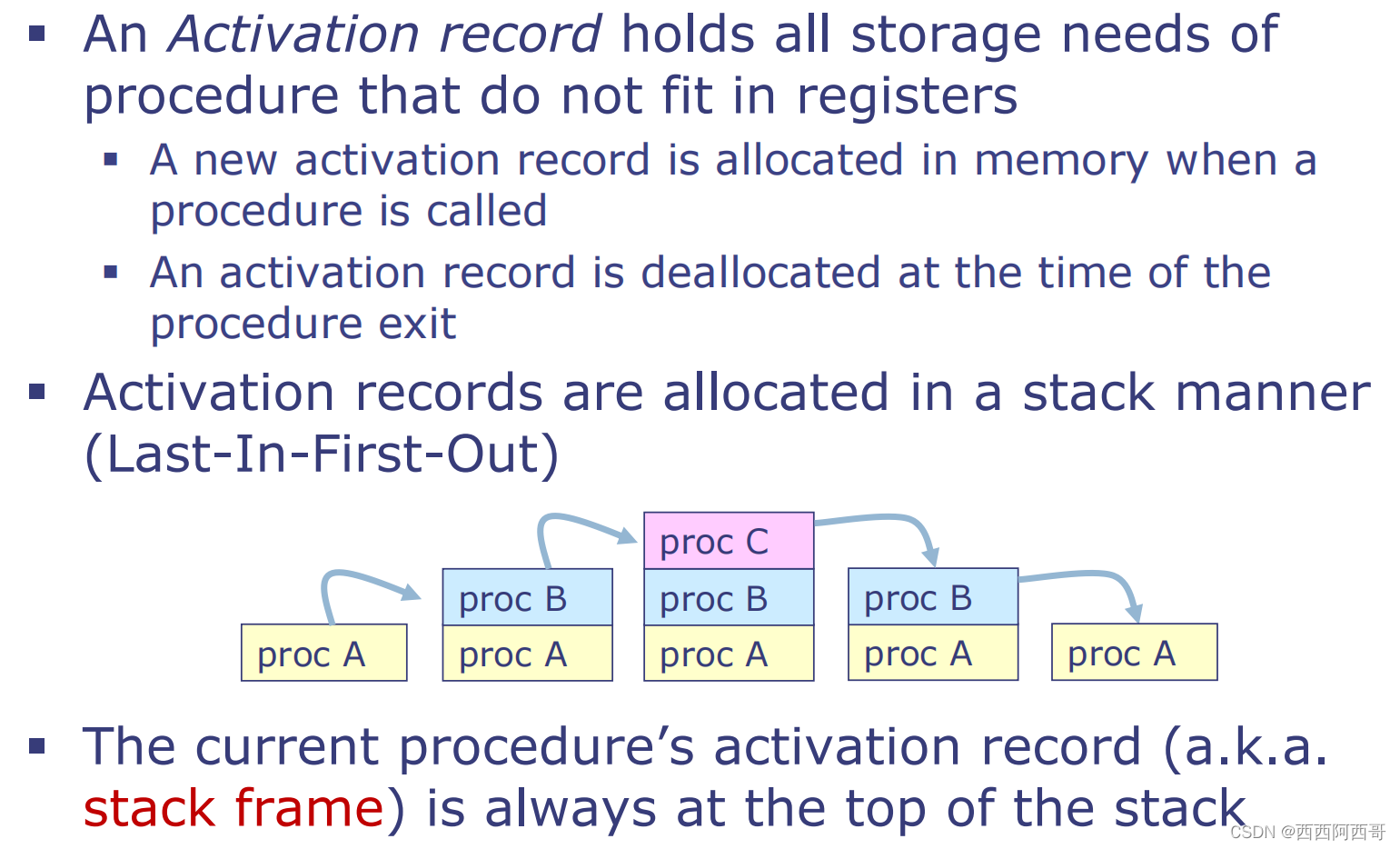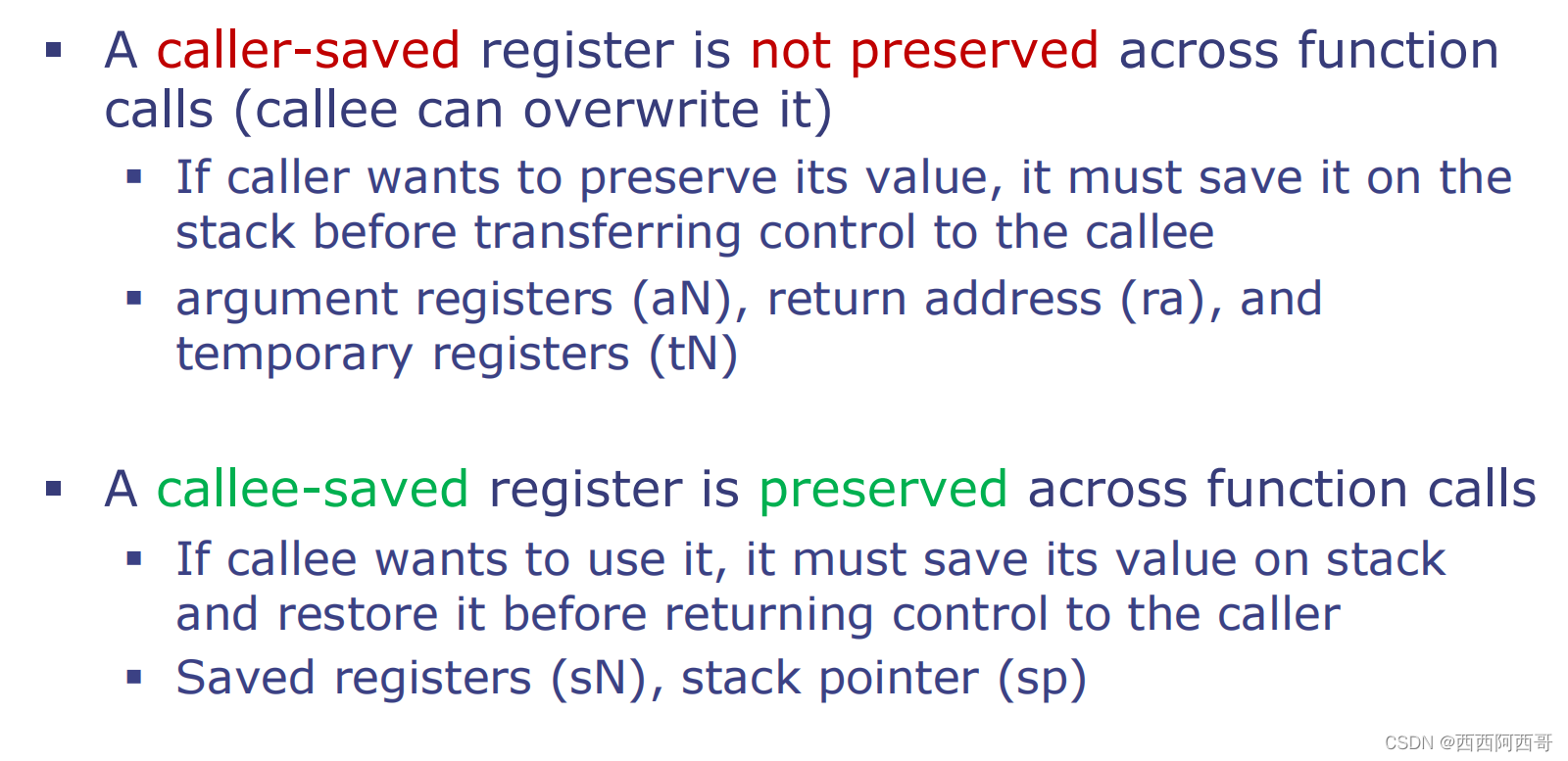Compiling Code and Implementing Procedures
1. Compiling Code
1.1 Compiling Simple Expressions
- Assign variables to registers
- Use the li pseudoinstructions for large contants
- Translate operators into computational instructions(Use register-immediate instructions to handle operations with small contants)
//Example C Code
int x,y,z;
...
y = (x + 3) | (y + 123456);
z = (x * 4) ^ y;//^ denotes XOR
//RISC-V Assembly
//x:x10, y:x11, z:x12
//x13,x14 use for temporaries
addi x13, x10, 3
li x14, 123456
add x14, x11, x14
or x11, x13, x14
slli x13, x10, 2
xor x12, x13, x11
1.2 Compiling Conditionals
Use control instructions-SB type:Conditional Branches
BEQ – branch if equal (==)
BNE – branch if not equal (!=)
BLT – branch if less than (<)
BGE – branch if greater than or equal (>=)
BLTU – branch if less than using unsigned numbers (< unsigned)
BGEU – branch if greater than or equal using unsigned numbers (>= unsigned)
Example:
1.2.1 If Statements
int x,y;
...//赋值语句
if(x < y){
y = y - x;
}
//implementation by beqz
//x: x10, y: x11
slt x12, x10, x11
beqz x12, endif
sub x11, x11, x10
endif:
//implementation by bge
bge x10, x11, endif
sub x11, x11, x10
endif:
1.2.2 If-else Statements
int x,y;
...//赋值语句
if(x < y){
y = y - x;
}else{
y = x - y;
}
//x: x10, y:x11
slt x12, x10, x11
beqz x12,else
sub x11, x11, x10
j endif
else:
sub x11, x10, x11
endif:
1.3 Compiling Loops
Loops cna be compiled using backward branched:
//C code
while(expr){
while-body
}
//RISC-V Assemlby
while:
(compile expr into xN)
beqz xN, endwhile //condation jumping out if loops
(compile while body)
j while //key of implemention of loops
endwhile:
//concise version,we don't need to jump to endwhile in precess but sequentially execute loop and compare
//what we need to append is to change our begining location to label 'compare' by psuedoinstruction j
j compare
loop:
(compile while-body)
compare:
(compare expr into xN)
bnez xN, loop
1.4 Put It All Together
while(x != y){
if(x > y){
x = x - y;
}else{
y = y - x;
}
}
//RISC-V Assembly
//x: x10, y: x11
j compare
loop:
bge x11, x10, else
sub x10, x10, x11
j endif;
else:
sub x11, x11, x10
endif:
compare:
bne x10, x11, loop
2. Implementing Procedures
2.1 Procedures
- Procedure(a.k.a. function or subroutine):Reusable code fragement that performs a specific task
- Single named entry point
- Zero or more foraml arguments
- Local storage
- Returns to the caller when finished
- Using procedures enables abstraction and reuse
- Copose large programs from collections of simple precedures
//greatest commom divisor
int gcd(int a,int b){
int x = a;
int y = b;
while(x != y){
if(x > y)x -= y;
else y -= x;
}
return x;
}
bool coprimes(int a,int b){
return gcd(a,b) == 1;
}
coprimes(5, 10); //false
coprimes(9,10); //ture
//compiling loops
// x: x10, y: x11
j compare
loop:
ble x10, x11 else
sub x10, x10, x11
j endif
else:
sub x11, x11, x10
endif:
compare: bne x10, x11, loop
2.2 Arguments and Return Values
- A caller need to pass arguments to the called procedure,as well as get results back from the called procedure
- both are done through registers
- A calling convention specifies rules for register usage across procedures
- RISC-V calling convention gives symbolic names to registers x0-x31 to denote their role:
| Symbolic name | Registers | Description |
|---|---|---|
| a0 to a7 | x10 to x17 | Function arguments |
| a0 and a1 | x10 and x11 | Function return values |
2.3 Calling Procedures
A procedure can be called from many different places
- The caller can get to the called procedure code simply by executing an unconditional jump instruction
- However, to return to the correct place in the calling procedure,the called procedure has to know which of the possible return address it should use
- Return address must be saved and passed to the called procedure!
2.4 Procedure Linking
How to transfer control to callee and to caller?
proc_call: jal ra,label
- Stores adress of proc_call + 4 in register ra(return adress register)
- Jumps to instruction at adress label where label is the name of the procedure
- After executing procedure ,jr ra to return the caller and continue execution
2.5 Managing a Procedure’s Register Space
- A caller uses the same register set as the called procedure
- Either the caller or the callee save the caller’s registers in memory and restores them when the procedure call has completed execution
2.6 Calling Convention
RISC-V calling convention gives symbolic names to registers x0 - x31 to denote their role:
| Symbolic name | Registers | Description | Saver |
|---|---|---|---|
| a0 to a7 | x10 to x1 | Function arguments | Caller |
| a0 and a1 | x10 and x11 | Function return values | Caller |
| ra | x1 | Reruen address | Caller |
| t0 to t6 | x5-7,x28-31 | Temporaries | Caller |
| s0 to s11 | x8-9,x18-27 | Saved registers | Callee |
| sp | x2 | Stack pointer | Callee |
| gp | s3 | Global pointer | - - - |
| tp | x4 | Thread Pointer | - - - |
| zero | x0 | Hardwired zero | - - - |
2.7 Procedure Storage Needs
-
Basic requirements for procedure calls
- input arguments
- Retuen address
- Results
- Use registers for 1\2\3
-
Local Storage:
- Variables that compiler can’t fit in registers
- Space to save register values according to the calling convention
2.8 Activition Record and Procedure Calls

2.9 Caller Saved vs Callee Saved Registers























 1347
1347











 被折叠的 条评论
为什么被折叠?
被折叠的 条评论
为什么被折叠?








